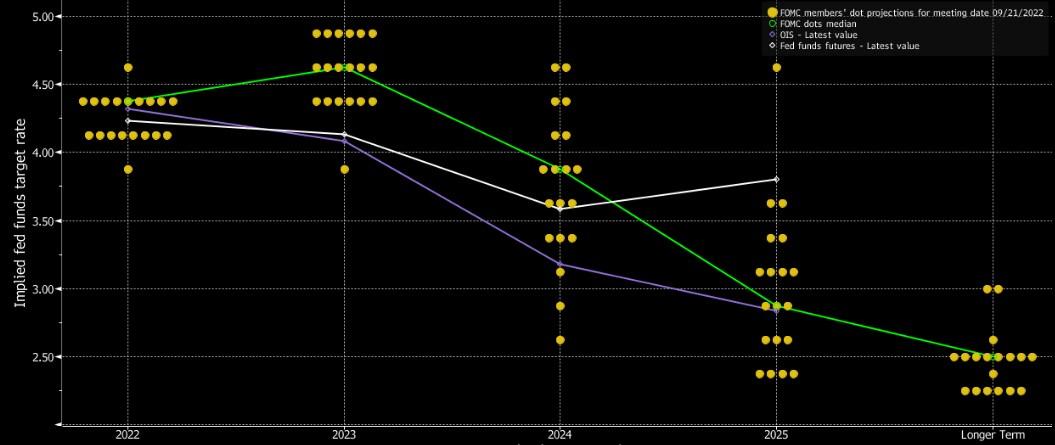Stock market today: S&P 500 closes lower as Oracle, Nvidia lead wobble in AI trade
- There are far more elements to this year's bear market than just rising interest rates
- Historically, the S&P 500 has actually risen on average in the three, six, and twelve months that followed a rate hike by the Fed
- Seasonality also points to a difficult October
Earlier this week, the Federal Reserve announced its third consecutive 75 basis point hike, bringing base interest rates to levels unseen since the beginning of the Global Financial Crisis (GFC) fourteen years ago.
Forecasts point to rates ending the year above 4.25%, implying a new 75bps hike in November and another 50bps in December. For 2023, the expected rate is as high as 4.6%.
And this is where the dot plot comes into play. The document containing the outlook for interest rates of the various members that make up the Fed also gives important hints of where rates might be up to 2025.
The dots in the diagram represent the committee member and their view of the future of rate hikes or rate cuts. However, to which specific member each of the dots belongs is unknown.

Source: Fed
Fed's Historical Relationship With The Market
However, if we look at the last times the Fed raised interest rates (1987, 1988, 1994, 1997, 1999, 2004, and 2015), we will see that, on average, the S&P 500 actually gained in the three (+0.5%), six (+7.1%), and twelve months (+10.2%) that followed the hikes.
The three-month number seems distorted by 1997's performance when the index gained +13.6%. So, excluding the outlier, the market went on a short-term losing streak every time the Fed raised interest rates but recovered shortly after, posing solid mid-term returns.
In fact, the S&P 500 only dropped twice six months after a Fed hike (1994 and now) and once in the twelve months that followed (1987). Will now be the second time?
Likely, yes, because there are far more elements this time, such as global inflation, the risk of a worldwide economic recession, and the Russian war in Ukraine, which remains far from a resolution even after seven months of combat.
Thus, despite the historical relationship displayed above, one cannot be reasonably optimistic about equity markets today. On Wall Street, they certainly are not. Just look at the following:
- Bank of America believes Wall Street has not yet seen the worst. The bank recently stated that in an environment of high inflation and with the Federal Reserve accelerating interest rate hikes, the downtrend should be prolonged, with a recession will likely pushing stocks to new lows.
- Ray Dalio believes that if rates peak near 4.5% next year, stock prices could sink by another -20%.
- In Europe, Germany's Bundesbank added to the negative sentiment and said signs of recession in the country are becoming increasingly evident.
Meanwhile, the S&P 500 has hit another grim milestone in 2022: It has fallen by more than -1% in 25% of the year's trading days.
Since the five-day trading week began in 1952, the only years with a higher percentage of days falling -1% or more are 1974 (26.6%), 2002 (28.6%), and 2008 (29.6%). By the way, those three years ended with the index dropping by -29.7%, -23.3%, and -38.5%, respectively.
Seasonality Is Yet Another Problem For S&P 500
The difficulties for the markets, far from disappearing, remain unchanged. But not only because of inflation and interest rate hikes. It is also due to the seasonal pattern.
Indeed, the second half of September is one of the most difficult periods for the stock market on a historical basis. The S&P 500 has fallen by an average of -0.75% since 1950. And that's not all; October is historically the most volatile month of the year. In fact, since World War II, October's average volatility has been +36% higher than the average for the other eleven months of the year.
Disclosure: The author does not hold any of the securities mentioned in this article.
